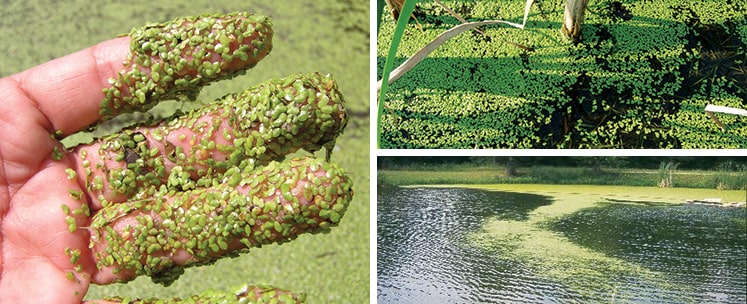Duckweed

What is Duckweed?
Duckweed is a very small floating plant. It has shoe-sole shaped leaves with a small, hair-like root hanging below. It looks like a four-leaf clover approximately the size of a pencil eraser. Duckweed in ponds is frequently misidentified as algae or watermeal. Once established, duckweed plants can cover the entire water surface and resemble a golf course green. It can cut off sunlight to submersed plants and cut off oxygen to fish and other wildlife. Keep reading to learn how to get rid of duckweed and manage it throughout the season.
Mechanical Duckweed Control
One duckweed removal method is to use a pond rake or debris skimmer to take it off the pond's surface.
Duckweed typically prefers stagnant and slow-moving water. By installing a pond aerator, you can eliminate duckweed completely or limit the growth to the edges, which are easily reachable with a hand skimmer.
Chemical Duckweed Control
If you'd want to learn how to kill duckweed and would prefer duckweed killer to managing things by hand, there are several options to control duckweed in ponds.
- Use a season-long herbicide such as Airmax WipeOut or Sonar A.S.. One application treats the entire body of water for duckweed and many other common pond weeds for the season.
- Use a broad-spectrum contact herbicide, such as Ultra PondWeed Defense, which will quickly kill duckweed. Because it doesn't stay in the water body, multiple treatments may be needed throughout the season.
- Try KnockDown Defense, a fast and selective herbicide that controls tough invasive and nuisance aquatic plants.
Chemical Application Best Practices
Anytime you use chemicals to treat weeds and algae, please keep in mind the following:
- When beginning duckweed control, treat your pond in sections. Treat only half the pond's surface at a time. During hot weather or when treating heavy growth, it is important to treat no more than 1/4 of your pond at a time and wait the full 14 days before re-applying. This helps lower the risk of fish loss during hot weather or when treating heavy growth.
- Once the weeds have browned, use a pond rake to remove as much dead material as possible. This prevents an accumulation of dead plant material and muck.
- Take a proactive approach to pond management. Use PondClear, MuckAway and Pond Dye to keep your pond looking great. For more information, read our resource on the Airmax Ecosystem or our Pond Dye Selection Guide.
Ask an Expert
If you're unable to identify your pond weed(s) using our Weed ID Guide, send us a photo so we can help you out. And if you have any additional questions about duckweed or how to get rid of duckweed in your pond, feel free to reach out to our customer service team and we'll be happy to assist you.